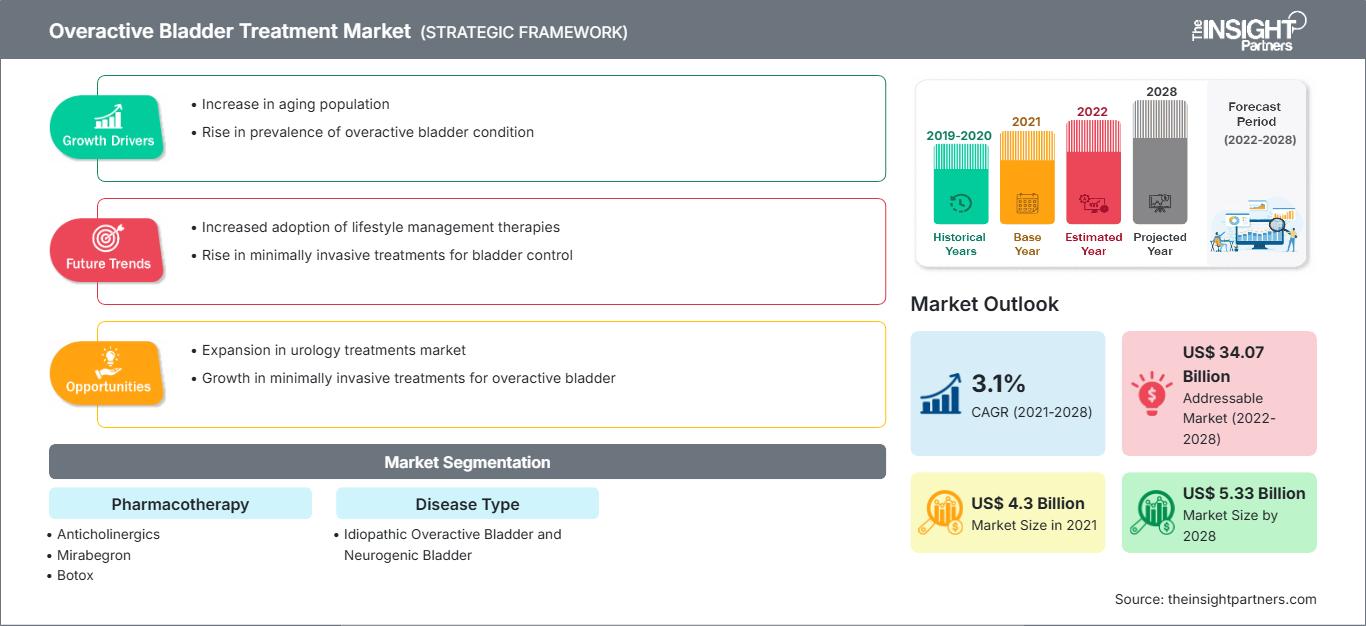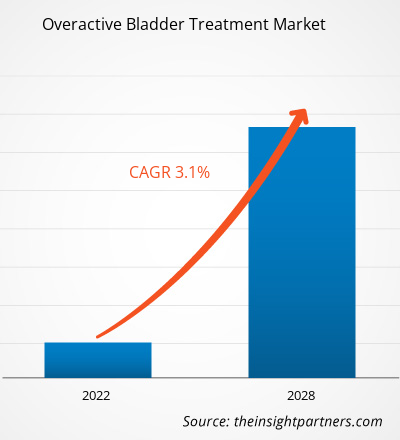Si prevede che il mercato del trattamento della vescica iperattiva crescerà da 4.295,93 milioni di dollari nel 2021 a 5.333,92 milioni di dollari entro il 2028; si stima una crescita a un CAGR del 3,1% dal 2022 al 2028.
La vescica iperattiva (OAB) è il bisogno frequente e improvviso di urinare, che potrebbe essere difficile da controllare. La OAB può essere causata da traumi addominali, infezioni, danni ai nervi e alcuni farmaci. La OAB è comune nelle persone di età pari o superiore a 65 anni. Le donne possono soffrire di OAB dopo i 45 anni. Il trattamento include la modifica di determinati comportamenti, l'assunzione di farmaci e la stimolazione nervosa.
Il mercato del trattamento della vescica iperattiva è segmentato in base a farmacoterapia, tipo di patologia e area geografica. Per area geografica, il mercato è ampiamente segmentato in Nord America, Europa, Asia-Pacifico, Medio Oriente e Africa e America meridionale e centrale. Il rapporto di mercato sul trattamento della vescica iperattiva offre approfondimenti e analisi approfondite del mercato, sottolineando parametri quali tendenze di mercato, dinamiche di mercato e analisi competitiva dei principali attori del mercato a livello mondiale.
Personalizza questo rapporto in base alle tue esigenze
Potrai personalizzare gratuitamente qualsiasi rapporto, comprese parti di questo rapporto, o analisi a livello di paese, pacchetto dati Excel, oltre a usufruire di grandi offerte e sconti per start-up e università
Mercato del trattamento della vescica iperattiva: Approfondimenti strategici

-
Ottieni le principali tendenze chiave del mercato di questo rapporto.Questo campione GRATUITO includerà l'analisi dei dati, che vanno dalle tendenze di mercato alle stime e alle previsioni.
Approfondimenti di mercato
Secondo i dati della National Association for Incontinence, nel 2018, circa 200 milioni di persone in tutto il mondo soffrivano di incontinenza urinaria. L'incontinenza da sforzo e l'incontinenza da urgenza sono i due tipi più comuni di incontinenza urinaria che colpiscono le donne, quest'ultima nota anche come vescica iperattiva. Analogamente, uno studio condotto da un gruppo di ricercatori dell'American College of Physicians e dell'Infectious Diseases Society of America nel 2020 ha affermato che le infezioni del tratto urinario (UTI) erano la causa di circa 6 milioni di visite mediche ogni anno negli Stati Uniti. In Canada, circa 500.000 visite mediche all'anno sono per consulenze sulle infezioni del tratto urinario. Le infezioni del tratto urinario rappresentano rispettivamente l'ottava e la quinta causa più comune di visite ambulatoriali e di accessi al pronto soccorso nel Paese. Pertanto, la crescente prevalenza dell'incontinenza urinaria e la crescente incidenza delle infezioni del tratto urinario stanno trainando il mercato del trattamento della vescica iperattiva.
Di seguito sono riportati alcuni esempi di lanci e approvazioni di nuovi prodotti:
- A febbraio 2022, Alembic Pharmaceuticals ha ricevuto l'approvazione dall'autorità di regolamentazione sanitaria statunitense per la sua versione generica di compresse a rilascio prolungato di fesoterodina fumarato, utilizzate per la vescica iperattiva negli adulti con sintomi di incontinenza urinaria, urgenza e frequenza. L'approvazione da parte della Food & Drug Administration (USFDA) statunitense per la domanda abbreviata di nuovo farmaco (ANDA) per le compresse a rilascio prolungato di fesoterodina fumarato riguarda i dosaggi di 4 mg e 8 mg.
- Ad aprile 2022, Axonics, Inc., un'azienda globale di tecnologia medica che sviluppa e commercializza nuovi prodotti per il trattamento delle disfunzioni vescicali e intestinali, ha annunciato il lancio completo di Axonics F15 negli Stati Uniti. Il sistema di neuromodulazione sacrale (SNM) di nuova concezione, di lunga durata e completamente privo di ricarica, ha ricevuto l'approvazione della FDA a marzo. Il sistema Axonics senza ricarica rappresenta un gradito progresso per i pazienti affetti da disfunzioni vescicali e intestinali.
- A marzo 2021, Myrbetriq di Astellas Pharma, utilizzato per il trattamento dell'iperattività neurogena del detrusore (NDO) nei pazienti pediatrici di età pari o superiore a tre anni (con peso pari o superiore a 35 kg), e Myrbetriq Granules, per il trattamento dell'NDO nei pazienti pediatrici di età pari o superiore a tre anni, sono stati approvati dalla Food and Drug Administration (FDA) statunitense.
Tali sviluppi di prodotto da parte degli operatori del mercato stanno trainando il mercato del trattamento della vescica iperattiva.
Approfondimenti sul tipo
In base alla farmacoterapia, il mercato del trattamento della vescica iperattiva è segmentato in mirabegron, botox, neurostimolazione, anticolinergici e instillazione intravescicale. Il segmento del mirabegron ha detenuto la quota di mercato maggiore nel 2021 e si prevede che registrerà il CAGR più elevato durante il periodo di previsione. Mirabegron è usato da solo o in associazione a solifenacina per il trattamento della vescica iperattiva negli adulti. È usato per trattare l'iperattività neurogena del detrusore (una condizione di controllo della vescica causata da problemi cerebrali, del midollo spinale o nervosi) nei bambini di età pari o superiore a tre anni. Mirabegron appartiene alla classe di farmaci chiamati agonisti beta-3 adrenergici. Rilassa i muscoli della vescica per prevenire la minzione urgente, frequente o incontrollata. Mirabegron è disponibile sotto forma di compressa a rilascio prolungato (a lunga durata d'azione) e sospensione a rilascio prolungato per via orale. Nell'ottobre 2022, Zydus Pharmaceuticals Inc. ha ricevuto l'approvazione dalla USFDA per commercializzare le compresse a rilascio prolungato di Mirabegron USP da 25 mg e 50 mg. Si prevede che la crescente domanda di questa terapia alimenterà la crescita del mercato del trattamento della vescica iperattiva durante il periodo di previsione.
Approfondimenti sui servizi
In base alla farmacoterapia, il mercato del trattamento della vescica iperattiva è segmentato in mirabegron, Botox, neurostimolazione, anticolinergici e instillazione intravescicale. Si prevede che il segmento della neurostimolazione registrerà il CAGR più elevato del mercato durante il periodo di previsione. Il controllo neurologico della vescica è complesso e dipende da diversi nervi spinali, centrali e periferici e dalle loro molteplici vie riflesse. Il controllo neurologico viene eseguito in diverse sedi del corpo umano e, pertanto, coinvolge diversi nervi. Alcuni di questi nervi bersaglio sono direttamente coinvolti nel controllo sensomotorio delle basse vie urinarie, come i nervi sacrale o pudendo, mentre altri sono coinvolti in modo più indiretto. La stimolazione elettrica viene utilizzata per attivare questi nervi e controllare la vescica.
Partnership e collaborazioni sono strategie ampiamente adottate dagli operatori del mercato globale del trattamento della vescica iperattiva. Di seguito sono elencati alcuni dei recenti sviluppi chiave del mercato:
- Nell'aprile 2021, Medtronic plc ha annunciato l'approvazione della Food and Drug Administration (FDA) statunitense per procedere con uno studio di esenzione per dispositivi sperimentali (IDE) per valutare il suo dispositivo di neuromodulazione tibiale impiantabile (TNM) sviluppato internamente, una terapia progettata per alleviare i sintomi dell'incontinenza vescicale.
- Nel luglio 2020, Hisamitsu Pharmaceutical Co., Inc. ha annunciato l'approvazione della produzione e della commercializzazione di OABLOK PATCH in Thailandia. Il prodotto è una formulazione transdermica sistemica sviluppata utilizzando la tecnologia Transdermal Drug Delivery System (TDDS) di Hisamitsu per il trattamento della vescica iperattiva con sintomi quali urgenza urinaria e minzione frequente.
- A luglio 2019, Teva Pharmaceuticals Ltd. ha lanciato le compresse di solifenacina succinato, antagonisti muscarinici indicati per il trattamento della vescica iperattiva con sintomi di incontinenza urinaria e aumento della frequenza urinaria.
La pandemia di COVID-19 ha mostrato alcuni scenari favorevoli per gli operatori che operano nel mercato del trattamento della vescica iperattiva. Gli Stati Uniti sono stati il paese più colpito del Nord America. L'infezione ha colpito gravemente la popolazione geriatrica del paese, causando varie complicazioni e causando la morte di un'ampia popolazione. Ad esempio, al 16 maggio 2022, gli Stati Uniti hanno segnalato 84.230.829 casi di COVID con 1.026.670 decessi. Pertanto, il trattamento della vescica iperattiva e una cura adeguata sono necessari per prevenire casi cronici di infezioni e problemi di salute.
Dopo l'epidemia di COVID-19, si è registrato un aumento dell'incidenza di vescica iperattiva. Secondo uno studio dell'American Urological Association, i pazienti con infezioni da COVID-19 presentavano un rischio maggiore di sviluppare nuovi sintomi o peggiorare quelli già presenti. Inoltre, circa un terzo dei pazienti con COVID-19 ha riportato un aumento significativo dei sintomi clinici durante l'International Consultation on Incontinence Questionnaire Overactive Bladder Module (ICIQ-OAB), condotto due mesi dopo l'infezione. Di questo terzo di pazienti, circa 1 su 5, ha riferito che i sintomi della vescica iperattiva erano nuovi. Questa maggiore prevalenza di vescica iperattiva dovuta al COVID-19 ha avuto un impatto positivo sulla domanda di trattamento della vescica iperattiva durante la pandemia.
Approfondimenti regionali sul mercato del trattamento della vescica iperattiva
Le tendenze regionali e i fattori che influenzano il mercato del trattamento della vescica iperattiva durante il periodo di previsione sono stati ampiamente spiegati dagli analisti di The Insight Partners. Questa sezione illustra anche i segmenti e la geografia del mercato del trattamento della vescica iperattiva in Nord America, Europa, Asia-Pacifico, Medio Oriente e Africa, America meridionale e centrale.
Ambito del rapporto di mercato sul trattamento della vescica iperattiva
| Attributo del rapporto | Dettagli |
|---|---|
| Dimensioni del mercato in 2021 | US$ 4.3 Billion |
| Dimensioni del mercato per 2028 | US$ 5.33 Billion |
| CAGR globale (2021 - 2028) | 3.1% |
| Dati storici | 2019-2020 |
| Periodo di previsione | 2022-2028 |
| Segmenti coperti |
By Farmacoterapia
|
| Regioni e paesi coperti |
Nord America
|
| Leader di mercato e profili aziendali chiave |
|
Densità degli operatori del mercato del trattamento della vescica iperattiva: comprendere il suo impatto sulle dinamiche aziendali
Il mercato del trattamento della vescica iperattiva è in rapida crescita, trainato dalla crescente domanda da parte degli utenti finali, dovuta a fattori quali l'evoluzione delle preferenze dei consumatori, i progressi tecnologici e una maggiore consapevolezza dei benefici del prodotto. Con l'aumento della domanda, le aziende stanno ampliando la propria offerta, innovando per soddisfare le esigenze dei consumatori e sfruttando le tendenze emergenti, alimentando ulteriormente la crescita del mercato.

- Ottieni il Mercato del trattamento della vescica iperattiva Panoramica dei principali attori chiave
Trattamento della vescica iperattiva - Segmentazione del mercato
Il mercato globale del trattamento della vescica iperattiva viene analizzato in base alla farmacoterapia, al tipo di patologia e all'area geografica. In base alla farmacoterapia, il mercato del trattamento della vescica iperattiva è classificato in mirabegron, Botox, neurostimolazione, anticolinergici e instillazione intravescicale. In base al tipo di patologia, il mercato è suddiviso in vescica iperattiva idiopatica e vescica neurogena.
Geograficamente, il mercato del trattamento della vescica iperattiva è segmentato in Nord America, Europa, Asia-Pacifico, Medio Oriente e Africa e Sud e Centro America.Profili aziendali
- Alembic Pharmaceuticals Limited
- Astellas Pharma Inc
- AbbVie Inc
- Teva Pharmaceuticals Industries Ltd
- Endo Pharmaceuticals Inc
- Hisamitsu Pharmaceutical Co. Inc
- Medtronic Plc
- Colorado Urology Associates, PLLC
- Axonics Modulation Technologies, Inc
- Pfizer Inc
- Analisi storica (2 anni), anno base, previsione (7 anni) con CAGR
- Analisi PEST e SWOT
- Valore/volume delle dimensioni del mercato - Globale, Regionale, Nazionale
- Industria e panorama competitivo
- Set di dati Excel
Report recenti
Testimonianze
Motivo dell'acquisto
- Processo decisionale informato
- Comprensione delle dinamiche di mercato
- Analisi competitiva
- Analisi dei clienti
- Previsioni di mercato
- Mitigazione del rischio
- Pianificazione strategica
- Giustificazione degli investimenti
- Identificazione dei mercati emergenti
- Miglioramento delle strategie di marketing
- Aumento dell'efficienza operativa
- Allineamento alle tendenze normative






















 Ottieni un campione gratuito per - Mercato del trattamento della vescica iperattiva
Ottieni un campione gratuito per - Mercato del trattamento della vescica iperattiva